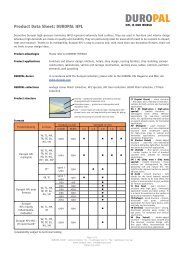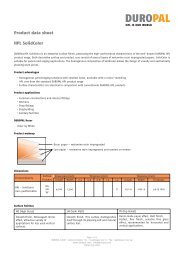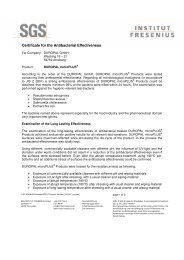duropal - Hpl- tecHno- loGY
duropal - Hpl- tecHno- loGY
duropal - Hpl- tecHno- loGY
Create successful ePaper yourself
Turn your PDF publications into a flip-book with our unique Google optimized e-Paper software.
Postforming<br />
– Mill one side of the area for forming to approx. 1 mm, depending on the desired radius.<br />
– Avoid overheating during the milling process and ensure that the tool and work piece<br />
are guided correctly so as not to jeopardise the postforming properties.<br />
– Duropal-HPL-Solid is shaped under heat in a stationary postforming press.<br />
– Once the moulded Duropal-HPL-Solid has cooled, the remaining cavity is filled out with<br />
hardening synthetic resin or secured using adaptor pieces.<br />
Fixings<br />
– When attaching rigid objects (e.g. profiles, strips, fittings), make the drill holes in the<br />
Duropal-HPL-Solid a little larger for continuous screw attachments. With non-continuous<br />
screw attachments (e.g. splay dowels) make the drill holes for the objects being attached<br />
a little larger as well. Here, too, we advise the use of a lubricant film between the object<br />
and the Duropal-HPL-Solid.<br />
– Self-tapping screws with a slight angle offer good screw-holding values. However, predrilling<br />
is always required. The drill hole diameter must be one thread depth less than<br />
the outer diameter of the screw. When inserting screws, the drill hole must be at least<br />
1 mm deeper than the penetration depth of the screw. Screws should be lubricated before<br />
insertion.<br />
– The highest screw-holding value is achieved with splay dowels, although they should not<br />
have any cutting burrs. The residual thickness of the Duropal-HPL-Solid must be at least<br />
1.5 mm. The use of expansion plugs parallel to the panel plane is not recommended.<br />
– For a thorough attachment, the drill holes should be at least 2-3 mm larger than the<br />
diameter of the fixing material. The required freedom of movement can be achieved by<br />
using elastic sleeves (e.g. polyamide).<br />
Doors<br />
– Small doors (e.g. for furniture) in Duropal-HPL-Solid can be fitted with two hinges.<br />
– Large doors for toilet cubicles and changing rooms should be attached by more than two<br />
hinges in order to guarantee the necessary stability.<br />
– When choosing hinges, take account of the necessary expansion play for Duropal-HPL-<br />
Solid. In order to keep it small, the door panel should be cut lengthwise out of the board.<br />
The frame construction must be stable, level and stress-free; the door latch, locks and<br />
any rubber seals must not create constant tension in the door panel.<br />
– A constant increase in humidity and/or temperature on one side of the door may distort<br />
the panel. You should therefore ensure that there is an adequate circulation of air.<br />
_ 38










